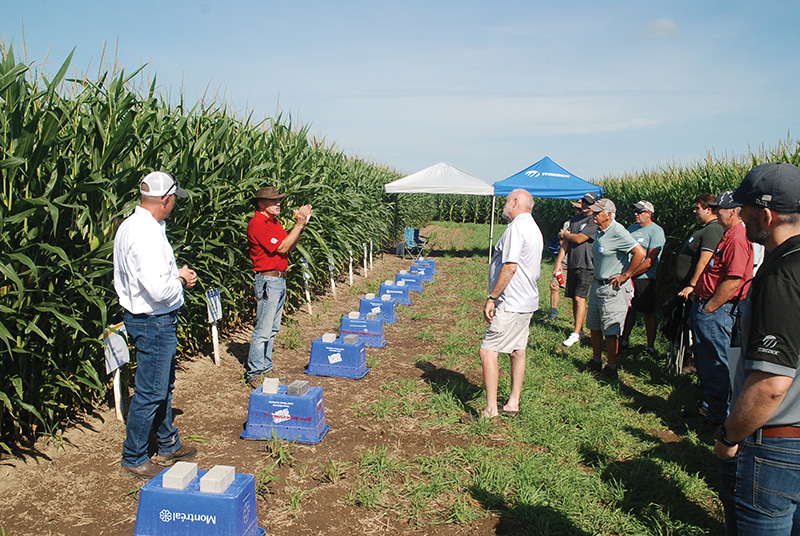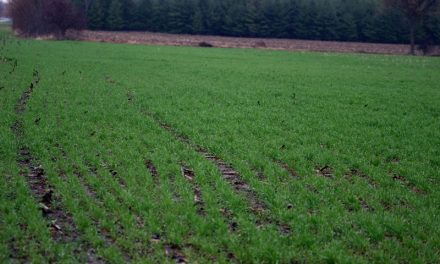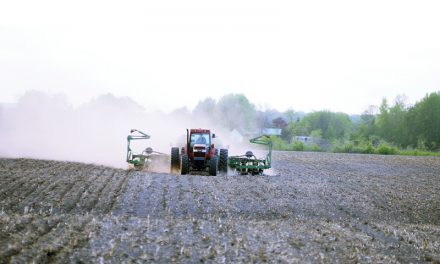Tim Laatsch and Peter Johnson explained the different ways to make the most out of nitrogen use. Morin Photo
CHESTERVILLE – As the growing season for 2022 begins to reach its end, the 7th Annual Great Ontario Yield Tour stopped in Chesterville at the Derk’s Elevator in Chesterville.
More than 100 registered for the daylong event that featured six working stations and three presentations at the end of the day.
The 2022 Great Ontario Yield Tour is a two-week data tour (corn kernel & soybean pod counting) from Aug. 15-26. The final leg of the tour was set for Sept. 1 at the Discovery Farm in Woodstock 744906 Oxford Rd 17.
The Chesterville stop enjoyed great summer weather and a day of informative and interesting demonstrations.
Groups of visitors were rotated through different workstations featuring different topics.
Featured were stations such as Maizex, describing how to get bigger kernels and Agronomists Peter Johnson and Tim Laatsch, talking about nitrogen stabilization, and how to use nitrogen stabilization products effectively as well as a look at what these products will have on a farmer’s fields and globally.
GPS Ontario was there with Morley and Jordan Wallace talking about growing more with less and Case IH held a demonstration about how to take advantage of the evolution in planter technology. Advanced Grain Handling systems had a presentation entitled “Why cheap dryers are so expensive” and TerraNova UAV had a presentation about how farmers can optimize crops by using state of the art technology drones. Alpine was at the tour showing how you could maximize fertilizer efficiency and Climate FieldView demonstrated how the use of collected data could be used to give farmers a competitive advantage.
Andres Hurtado, co-founder of TerraNova UAV said, “TerraNova UAV is a Canadian, precision agriculture drone services’ company.”
Its mission is to “help growers optimize crops by using state-of-the-art technology.”
Farmers can use the service to check for weeds, hydration requirements, surveying fields for up-to-date field status and using drones for spraying.
He said, “We offer multi-spectral imagery. That is our main package.”
They do plant count analyses to weed protection.
Hurtado said, “Farmers like to see different things; the effects of fertilizer on certain plants, others like to see plant counts and populations on fields. It can be very personalized, that’s what makes us different.”
Before any project, they like to learn from the farmer as much as they can about their fields, crops, and concerns.
“We see what a farmer is trying to achieve and then offer them solutions.”
Moe Agostino, chief commodity strategist with farms.com described why the tour was created seven years ago.
“The tour itself, when I started it, seven years ago, I wanted to level the playing field for the farmer,” he said.
“I felt the farmer did not have enough information to make marketing or production decisions versus the commercial elevator that they sell their product to.”
He said the tour would give participants a good insight into production.
“That could ultimately impact on how you manage your operation.”
He said last year’s tour was a record, “we had a great finish.”
“The experts will tell you that the new hybrids, whether it be corn or bean are racehorses.”
He said farmers in Ontario have to do a little more work managing their crops because of soil conditions compared to other parts of the country but their efforts have paid off.
“The corn yield last year was high. It was a record for Ontario, well above average.”
However, Agostino cautioned that typical corn and soybeans crops despite all of the precautions farmers take are not bullet proof.
“You could see in the western corn belt this year; in the United States you got brown crops and crops cut for silage. “We are not seeing hardly any of that in Ontario this year. It has been hotter and drier than last year particularly through June and July.”
Agostino said, “The way I look at it is that there are a lot more haves than have nots. There are a lot more garden spots, than dry spots. A garden spot looks good, a lot of consistency, and above average yields. We should get a good finish, and it looks like we will.
“What we learned from seven years on the tour is yield comes through kernel weight and size for soybeans, pod weight and size. Yes, you have to get it in early and yes, you have to get through the reproduction stage with no issues, once you get through that it’s that long finish, that slow cooking process that adds weight and size, and last year that is what happened,” said Agostino.
“This crop is as strong as last year, it could actually rival last year if it has a good finish. The key differences between last year and this year is that the corn is missing length. Typically, we measure plants in a thirty-foot row so that gives us ear count. Last year’s ear count was a record high, 30,500 plus.”
He said this year is close to the same or potentially more.
“We have the potential to produce more than last year.”
“This crop, this year of corn, could rival last year’s record.”
On the bean side, the number of pods determines how good the crop will be.
“You want to see three pods per plant but this year it is coming up a little short of that. “But we are not done yet.”
Agostino added, “We have really strong solid crops with no disaster on the horizon and if at the end of the day we get a good finish, these crops could surprise you.”
“The market is getting more and more difficult to predict. The volatility has increased.”
“We can only measure potential, and Mother Nature will determine how this season will turn out.”













